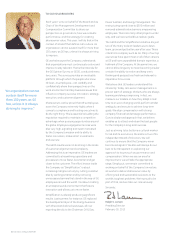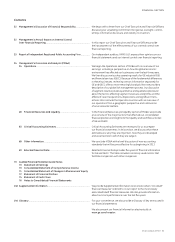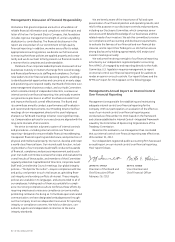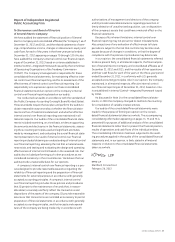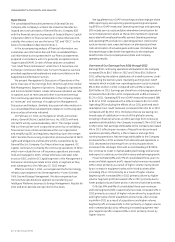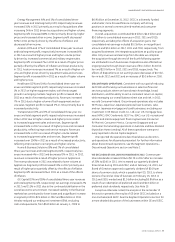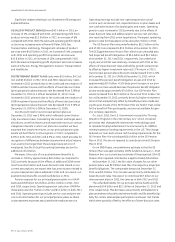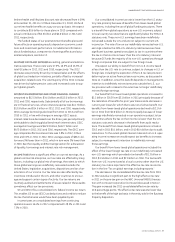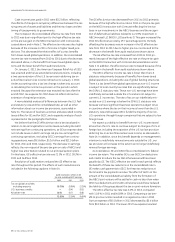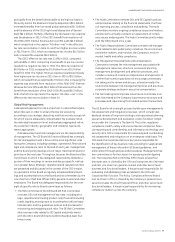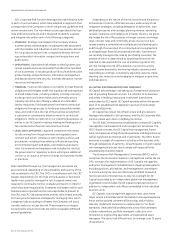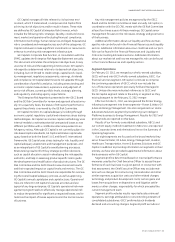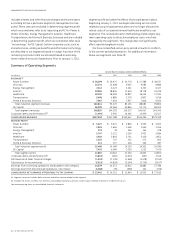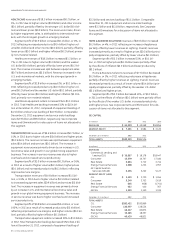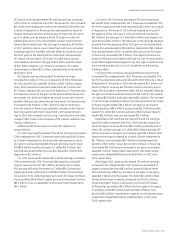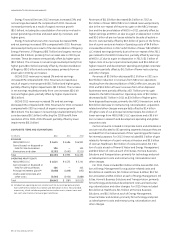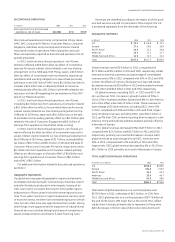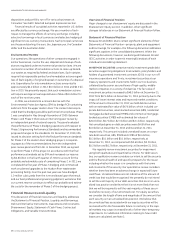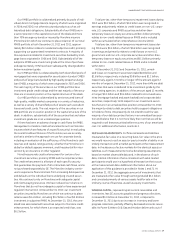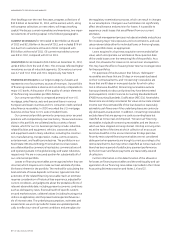GE 2012 Annual Report Download - page 42
Download and view the complete annual report
Please find page 42 of the 2012 GE annual report below. You can navigate through the pages in the report by either clicking on the pages listed below, or by using the keyword search tool below to find specific information within the annual report.management’s discussion and analsis
40 GE 2012 ANNUAL REPORT
GE’s Corporate Risk Function leverages the risk infrastructures
in each of our businesses, which have adopted an approach that
corresponds to the Company’s overall risk policies, guidelines and
review mechanisms. Our risk infrastructure operates at the busi-
ness and functional levels and is designed to identify, evaluate
and mitigate risks within each of the following categories:
Þ
STRATEGIC. Strategic risk relates to the Company’s future
business plans and strategies, including the risks associated
with the markets and industries in which we operate, demand
for our products and services, competitive threats, technol-
ogy and product innovation, mergers and acquisitions and
public policy.
Þ
OPERATIONAL. Operational risk relates to risks (systems, pro-
cesses, people and external events) that affect the operation
of our businesses. It includes product life cycle and execution,
product safety and performance, information management
and data protection and security, business disruption, human
resources and reputation.
Þ
FINANCIAL. Financial risk relates to our ability to meet financial
obligations and mitigate credit risk, liquidity risk and exposure
to broad market risks, including volatility in foreign currency
exchange rates and interest rates and commodity prices.
Liquidity risk is the risk of being unable to accommodate
liability maturities, fund asset growth and meet contractual
obligations through access to funding at reasonable market
rates, and credit risk is the risk of financial loss arising from
a customer or counterparty failure to meet its contractual
obligations. We face credit risk in our industrial businesses, as
well as in our GE Capital investing, lending and leasing activi-
ties and derivative financial instruments activities.
Þ
LEGAL AND COMPLIANCE. Legal and compliance risk relates
to risks arising from the government and regulatory envi-
ronment and action, compliance with integrity policies and
procedures, including those relating to financial reporting,
environmental health and safety, and intellectual property
risks. Government and regulatory risk includes the risk that
the government or regulatory actions will impose additional
cost on us or cause us to have to change our business models
or practices.
Risks identified through our risk management processes are
prioritized and, depending on the probability and severity of the
risk, escalated to the CRO. The CRO, in coordination with the CRC,
assigns responsibility for the risks to the business or functional
leader most suited to manage the risk. Assigned owners are
required to continually monitor, evaluate and report on risks for
which they bear responsibility. Enterprise risk leaders within each
business and corporate function are responsible to present to
the CRO and CRC risk assessments and key risks at least annually.
We have general response strategies for managing risks, which
categorize risks according to whether the Company will avoid,
transfer, reduce or accept the risk. These response strategies
are tailored to ensure that risks are within acceptable GE Board
general guidelines.
Depending on the nature of the risk involved and the particu-
lar business or function affected, we use a wide variety of risk
mitigation strategies, including delegation of authorities, stan-
dardized processes and strategic planning reviews, operating
reviews, insurance, and hedging. As a matter of policy, we gener-
ally hedge the risk of fluctuations in foreign currency exchange
rates, interest rates and commodity prices. Our service busi-
nesses employ a comprehensive tollgate process leading up to
and through the execution of a contractual service agreement
to mitigate legal, financial and operational risks. Furthermore,
we centrally manage some risks by purchasing insurance, the
amount of which is determined by balancing the level of risk
retained or assumed with the cost of transferring risk to oth-
ers. We manage the risk of fluctuations in economic activity
and customer demand by monitoring industry dynamics and
responding accordingly, including by adjusting capacity, imple-
menting cost reductions and engaging in mergers, acquisitions
and dispositions.
GE CAPITAL RISK MANAGEMENT AND OVERSIGHT
GE Capital acknowledges risk-taking as a fundamental character-
istic of providing financial services. It is inherent to its business
and arises in lending, leasing and investment transactions
undertaken by GE Capital. GE Capital operates within the param-
eters of its established risk appetite in pursuit of its strategic
goals and objectives.
GE Capital has robust risk infrastructure and processes to
manage risks related to its businesses, and the GE Corporate Risk
Function relies upon them in fulfilling its mission.
The GE Risk Committee was established to oversee GE Capital’s
risk appetite, risk assessment and management processes. The
GECC Board oversees the GE Capital risk management frame-
work, and approves all significant acquisitions and dispositions as
well as significant borrowings and investments. The GECC Board
exercises oversight of investment activities in the business units
through delegations of authority. All participants in the GE Capital
risk management process must comply with approval limits
established by the GECC Board.
The Enterprise Risk Management Committee (ERMC), which
comprises the most senior leaders in GE Capital as well as the GE
CRO, oversees the implementation of GE Capital’s risk appetite,
and senior management’s establishment of appropriate systems
(including policies, procedures, and management committees)
to ensure enterprise risks are effectively identified, measured,
monitored, and controlled. Day-to-day risk oversight for GE
Capital is provided by an independent global risk management
organization that includes the GE Capital corporate function in
addition to independent risk officers embedded in the individual
business units.
GE Capital’s risk management approach rests upon three
major tenets: a broad spread of risk based on managed exposure
limits; senior secured commercial financings; and a hold-to-
maturity model with transactions underwritten to “on-book”
standards. Dedicated risk professionals across the businesses
include underwriters, portfolio managers, collectors, envi-
ronmental or engineering specialists, and specialized asset
managers. The senior risk officers have, on average, over 25 years
of experience.


